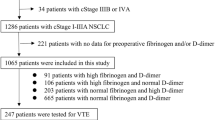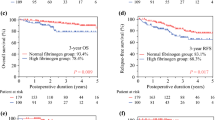Abstract
Objective
The plasma fibrinogen levels had not only been used as an independent prognostic parameter for the patients with non-small cell lung cancer (NSCLC), but also as a promising biomarker for evaluating the efficacy of chemotherapy. This study aimed to investigate the correlation between the plasma fibrinogen levels and epidermal growth factor receptor (EGFR) gene mutation and clinical-pathological characteristics of Chinese patients with NSCLC.
Methods
In this retrospective study, NSCLC specimens collected from 352 patients between November 2009 and November 2011 were selected to detect EGFR gene mutation with real-time polymerase chain reaction (RT-PCR). In these specimens, 308 ones were also detected EGFR gene copy number with fluorescence in situ hybridization (FISH). Coagulation makers were examined prior to the operations. The association between the plasma fibrinogen levels and EGFR gene mutation and clinical-pathological characteristics were analyzed using SPSS 16.0 software.
Results
The median pre-operation plasma fibrinogen level was 3.55 g/L (109/352) patients with higher plasma fibrinogen level (> 4.0 g/L). The lower plasma fibrinogen levels correlated significantly with EGFR gene mutations (P < 0.001), the similar result was seen in platelet counts (P = 0.026). A linear correlation was found between the plasma fibrinogen levels and the platelet counts in NSCLC patients (R 2 = 0.209, P < 0.001). Pre-operation plasma fibrinogen levels correlated with gender (P < 0.001), smoking status (P < 0.001), and histology (P < 0.001). There were significant link between the above clinical-pathological characteristics and EGFR gene mutations. In addition, EGFR gene mutation was correlated with FISH-positive status (P < 0.001). Moreover, both plasma fibrinogen level (P = 0.024) and the EGFR gene copy number (P = 0.040) had significant relationships with the pathological TNM stage.
Conclusion
This study showed that a significant relevance between plasma fibrinogen levels and EGFR gene mutations. The plasma fibrinogen level might be as a clinical decision parameter for evaluating the efficacy of anti-EGFR tyrosine kinase inhibitors (TKIs) in NSCLC. The patients of NSCLC had higher indicate have poor benefits from anti-EFGR TKIs. In addition, pre-operation plasma fibrinogen level could be used as an indepedent prognostic biomarker for the patients with NSCLC.
Similar content being viewed by others
References
Hirsch F R, Scagliotti G V, Langer C J, et al. Epidermal growth factor family of receptors in preneoplasia and lung cancer: perspectives for targeted therapies. Lung Cancer, 2003, 41: S29–S42.
Brabender J, Danenberg K D, Metzger R, et al. Epidermal growth factor receptor and HER2-neu mRNA expression in non-small cell lung cancer is correlated with survival. Clin Cancer Res, 2001, 7: 1850–1855.
Shiraishi M, Noguchi M, Shimosato Y, et al. Amplification of protoncogenes in surgical specimens of human lung carcinomas. Cancer Res, 1989, 49: 6474–6479.
Downward J, Yarden Y, Mayes E, et al. Close similarity of epidermal growth factor receptor and v-erb-B oncogene protein sequences. Nature, 1984, 307: 521–527.
Lynch TJ, Bell DW, Sordella R, et al. Activating mutations in the epidermal growth factor receptor underlying responsiveness of non-smallcell lung cancer to gefitinib. N Engl J Med, 2004, 350: 2129–2139.
Cappuzzo F. EGFR FISH versus mutation: different tests, different end-points. Lung Cancer, 2008, 60: 160–165.
Duga S, Asselta R, Santagostino E, et al. Missense mutations in the human beta fibrinogen gene cause congenital afibrinogenemia by impairing fibrinogen secretion. Blood, 2000, 95: 1336–1341.
Wojtukiewicz MZ, Zacharski LR, Moritz TE, et al. Prognostic significance of blood coagulation tests in carcinoma of the lung and colon. Blood Coagul Fibrinolysis, 1992, 3: 429–437.
Jones JM, Mcgonigle NC, Mcanespie M, et al. Plasma fibrinogen and serum C-reactive protein are associated with non-small cell lung cancer. Lung Cancer, 2006, 53: 97–101.
Cappuzzo F, Hirsch F R, Rossi E, et al. Epidermal growth factor receptor gene and protein and gefitinib sensitivity in non-small-cell lung cancer. J Natl Cancer Inst, 2005, 97: 643–655.
Sinha S, Luben RN, Welch A, et al. Fibrinogen and cigarette smoking in men and women in the European Prospective Investigation into Cancer in Norfolk (EPIC-Norfolk) population. Eur J Cardiovasc Prev Rehabil, 2005, 12:144–150.
Mok TS, Wu YL, Thongprasert S, et al. Gefitinib or carboplatin-paclitaxel in pulmonary adenocarcinoma. N Engl J Med, 2009, 361: 947–957.
Miller V A, Kris MG, Shah N, et al. Bronchioloalveolar pathologic subtype and smoking history predict sensitivity to gefitinib in advanced non-small-cell lung cancer. J Clin Oncol, 2004, 22: 1103–1109.
Kris MG, Natale RB, Herbst RS, et al. Efficacy of gefitinib, an inhibitor of the epidermal growth factor receptor tyrosine kinase, in symptomatic patients with non-small cell lung cancer: a randomized trial. JAMA, 2003, 290: 2149–2158.
Goldstraw P, Crowley J, Chansky K, et al. The IASLC Lung Cancer Staging Project: proposals for the revision of the TNM stage groupings in the forthcoming (seventh) edition of the TNM Classification of malignant tumours. J Thorac Oncol, 2007, 2: 706–714.
Zhang LJ, Cai L, Li Z, et al. Relationship between epidermal growth factor receptor gene mutation and copy number in Chinese patients with non-small cell lung cancer. Chin J Cancer, 2012, 31: 491–499.
Tokumo M, Toyooka S, Kiura K, et al. The relationship between epidermal growth factor receptor mutations and clinicopathologic features in non-small cell lung cancers. Clin Cancer Res, 2005, 11: 1167–1173.
Kosaka T, Yatabe Y, Endoh H, et al. Mutations of the epidermal growth factor receptor gene in lung cancer: biological and clinical implications. Cancer Res, 2004, 64: 8919–8923.
Zhu CQ, Da CS G, Ding K, et al. Role of KRAS and EGFR as biomarkers of response to erlotinib in National Cancer Institute of Canada Clinical Trials Group Study BR.21. J Clin Oncol, 2008, 26: 4268–4275.
Maemondo M, Minegishi Y, Inoue A, et al. First-line gefitinib in patients aged 75 or older with advanced non-small cell lung cancer harboring epidermal growth factor receptor mutations: NEJ 003 study. J Thorac Oncol, 2012, 7: 1417–1422.
Zhou Q, Zhang XC, Chen ZH, et al. Relative abundance of EGFR mutations predicts benefit from gefitinib treatment for advanced nonsmall-cell lung cancer. J Clin Oncol, 2011, 29: 3316–3321.
Maemondo M, Inoue A, Kobayashi K, et al. Gefitinib or chemotherapy for non-small-cell lung cancer with mutated EGFR. N Engl J Med, 2010, 362: 2380–2388.
Wojtukiewicz MZ, Zacharski LR, Moritz TE, et al. Prognostic significance of blood coagulation tests in carcinoma of the lung and colon. Blood Coagul Fibrinolysis, 1992, 3: 429–437.
Ferrigno D, Buccheri G, Ricca I. Prognostic significance of blood coagulation tests in lung cancer. Eur Respir J, 2001, 17: 667–673.
Zhang Y, Duan LC, Xiang XD, et al. The relationship between the level of activation markers of platelets in peripheral blood around operation and lung cancer. Chinese-German J Clin Oncol, 2008, 2: 84–86.
Handagama PJ, Shuman MA, Bainton DF. In vivo defibrination results in markedly decreased amounts of fibrinogen in rat megakaryocytes and platelets. Am J Pathol, 1990, 137: 1393–1399.
Takeuchi H, Ikeuchi S, Kitagawa Y, et al. Pretreatment plasma fibrinogen level correlates with tumor progression and metastasis in patients with squamous cell carcinoma of the esophagus. J Gastroenterol Hepatol, 2007, 22: 2222–2227.
Inoue A, Kobayashi K, Usui K, et al. First-line gefitinib for patients with advanced non-small-cell lung cancer harboring epidermal growth factor receptor mutations without indication for chemotherapy. J Clin Oncol, 2009, 27: 1394–1400.
Author information
Authors and Affiliations
Additional information
Supported by a grant from the Ministry of Science and Technology of China (No. 2012AA021502).
Rights and permissions
About this article
Cite this article
Zhu, J., Cai, L., Yang, H. et al. Plasma fibrinogen levels are associated with epidermal growth factor receptor gene mutation in Chinese patients with non-small cell lung cancer. Chin. -Ger. J. Clin. Oncol. 12, 203–209 (2013). https://doi.org/10.1007/s10330-013-1151-9
Received:
Revised:
Accepted:
Published:
Issue Date:
DOI: https://doi.org/10.1007/s10330-013-1151-9




